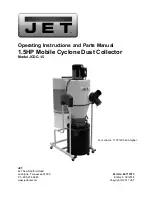
10
17. Install quick levers into threaded holes on cone
flanges, using screws (HP3). See Figure 12
18. Install hose (J) onto cone and drum lid and
secure with two hose clamps (K), at top and
bottom. See Figure 12.
Figure 12
The bag frame maintains the shape of the bag in the
negative-pressure environment of the cyclone drum.
Assemble bag frame as follows:
19. Screw the short and long frame supports into
the hoops in alternating manner, as shown in
Figure 13. Secure with twelve pan head screws
and hex nuts (HP10,HP11). (Note: The bends
on long supports point inward as shown.)
Figure 13
20. Place drum collection bag (P) into drum with its
top edge wrapped around top edge of drum.
Place bag frame (R) inside bag and press all the
way down. See Figure 14.
21. Pull down both quick levers (Q, Figure 12) then
assemble drum lid (H, Figure 12) to quick
levers. Tighten long nut (Q
1
, Figure 12) onto
each quick lever.
22. Raise drum lid using quick levers, and position
drum beneath lid. Lower quick levers to secure
lid upon drum.
Figure 14
6.0
Electrical connections
All electrical connections must
be done by a qualified electrician in compliance
with all local codes and ordinances. Failure to
comply may result in serious injury.
The JCDC-1.5 Dust Collector is rated at 115-volt
power only. The dust collector comes with a plug
designed for use on a circuit with a
grounded outlet
that looks like the one pictured in
A
, Figure 15.
Keep in mind that a circuit being used by other
machines, tools, lights, heaters, etc. at the same
time will add to the electrical load. A dedicated
circuit to the dust collector will offer best results
since dust collectors are generally used while other
tools are running.
Before connecting to power source, be sure switch
is in
off
position.
It is recommended that the dust collector be
connected to a dedicated 20 amp circuit with circuit
breaker or fuse. If connected to a circuit protected
by fuse, use time delay fuse marked “D”.
Local
codes take precedence over recommendations.
6.1
GROUNDING INSTRUCTIONS
This appliance must be grounded. If it should
malfunction or breakdown, grounding provides a
path of least resistance for electric current to reduce
the risk of electric shock. This appliance is equipped
with a cord having an equipment-grounding
conductor and grounding plug. The plug must be
inserted into an appropriate outlet that is properly
installed and grounded in accordance with all local
codes and ordinances.


























